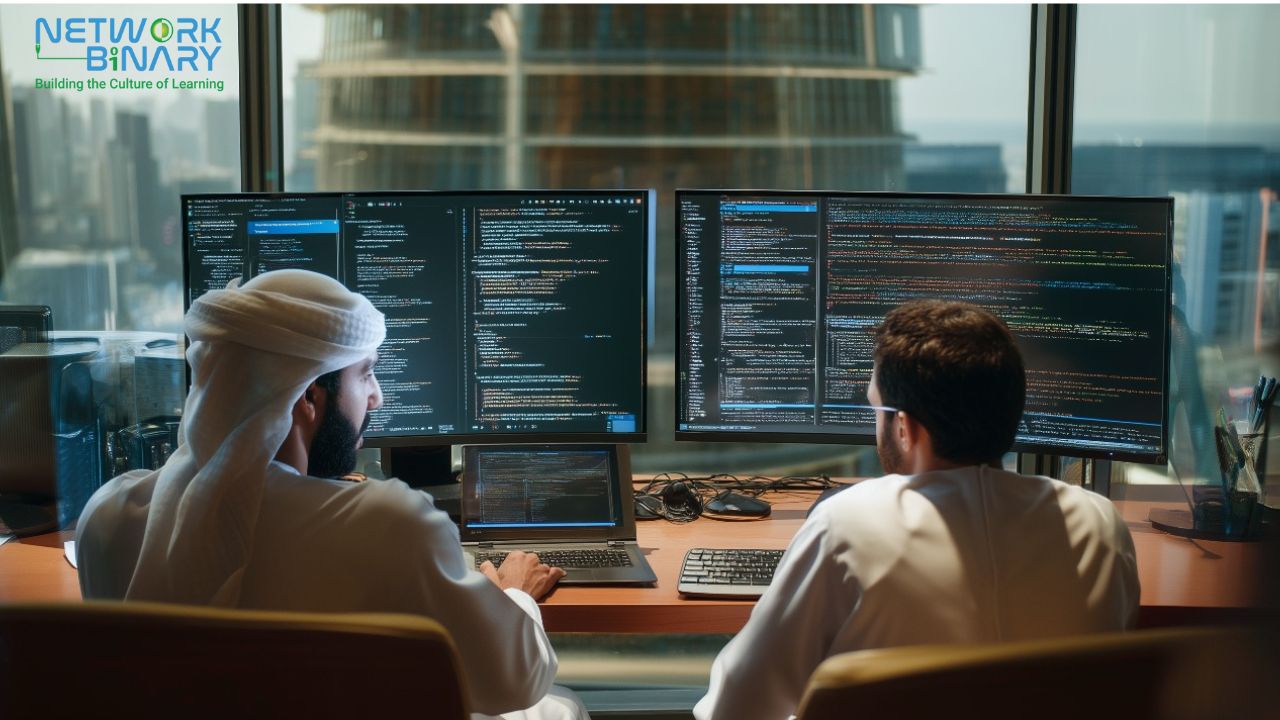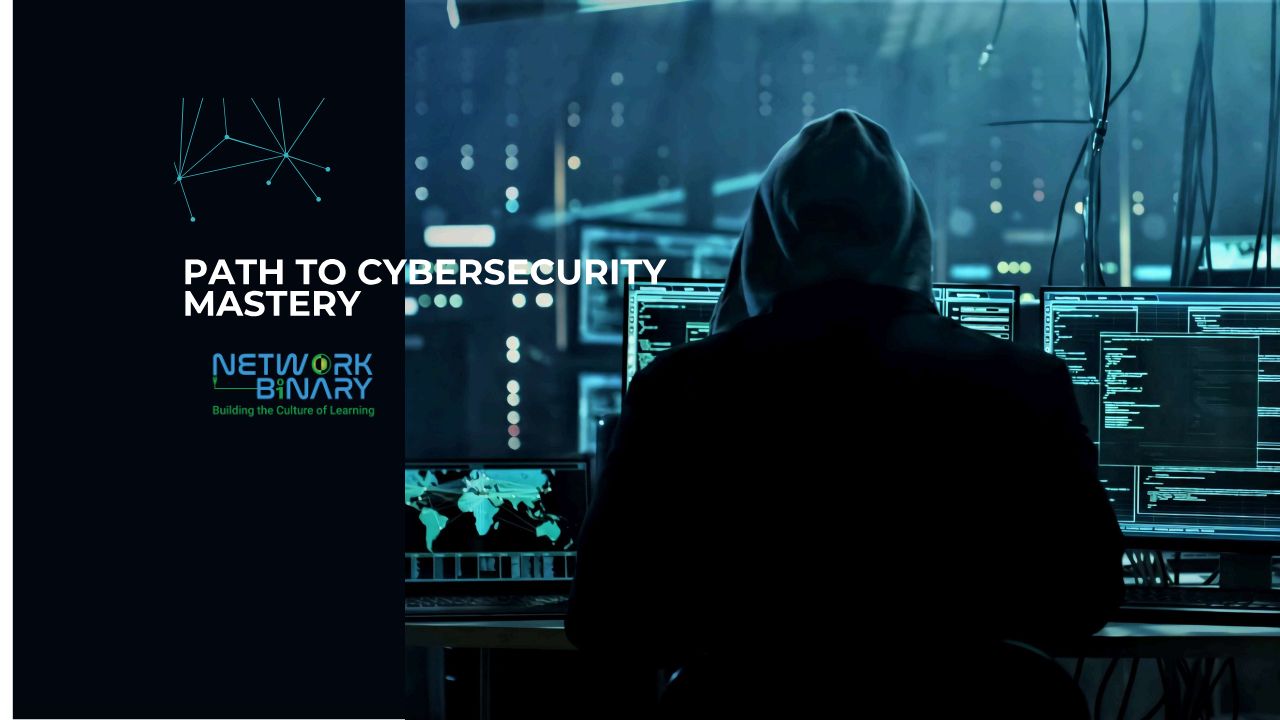
CCNA (200-301)
Earn your CCNA certification with Network Binary and build a strong foundation for a successful IT career. This industry-recognized certification validates your skills across key domains — networking fundamentals, IP services, security, and automation. Learn to configure and troubleshoot networks, set up secure access, understand routing protocols, and explore modern tools like APIs and controller-based networking. With hands-on labs and expert-led training, Network Binary equips you with real-world skills that employers are actively seeking in today’s tech-driven market.
No distractions. Just you!
Why Choose 1-on-1 Training
- Focused attention and face to face instructor support
- Custom Calendar & Training Schedule
- Highly interactive environment
- Learn via labs, mock tests, case studies, Q&A sessions
- On-spot doubt clearing opportunity
- Interview Support and Free Career Guidance
Course Description
Key Takeaways
- Identify the components of a computer network and describe their basic characteristics
- Understand the model of host-to-host communication
- Describe the features and functions of the Cisco IOS Software
- Describe LANs and the role of switches within LANs
- Describe Ethernet as the network access layer of TCP/IP and describe the operation of switches
- Install a switch and perform the initial configuration
- Describe the TCP/IP internet layer, IPv4, its addressing scheme, and subnetting
- Describe the TCP/IP transport layer and application layer
- Explore the functions of routing
- Implement basic configuration on a Cisco router
- Explain host-to-host communications across switches and routers
- Identify and resolve common switched network issues and common problems associated with IPv4 addressing
- Describe IPv6 main features, addresses and configure and verify basic IPv6 connectivity
- Describe the operation, benefits, and limitations of static routing
- Describe, implement and verify VLANs and trunks
- Describe the application and configuration of inter-VLAN routing
- Explain the basics of dynamic routing protocols and describe components and terms of OSPF
- Explain how STP and RSTP work
- Configure link aggregation using EtherChannel
- Describe the purpose of Layer 3 redundancy protocols
- Describe basic WAN and VPN concepts
- Describe the operation of ACLs and their applications in the network
- Configure internet access using DHCP clients and explain and configure NAT on Cisco routers
- Describe the basic QoS concepts
- Describe the concepts of wireless networks, which types of wireless networks can be built and how to use WLC
- Describe network and device architectures and introduce virtualization
- Explain software-defined networks
- Configure basic Cisco IOS system monitoring tools
- Describe the management of Cisco devices
- Describe the current security threat landscape
- Describe threat defense technologies
- Implement a basic security configuration of the device management plane
- Implement basic steps to harden network devices
- Discuss the need for network programmability in Enterprise networks, common programmability protocols, and configuration management tools.
- Introducing AI and ML in Network Operations
Who should attend
- Individuals preparing for the Cisco CCNA certification
- Entry-level Network Engineers
- Entry-level Network Administrators
- Entry-level Network Support Technicians
- Entry-level Help Desk Technicians
Prerequisites
- Familiarity with basic computer operations
- Ability to navigate and use a PC operating system
- Understanding of basic internet functionality and usage
- Foundational knowledge of IP addressing
Course Outline
- Section 1: Exploring the Functions of Networking
- Section 2: Introducing the Host-To-Host Communications Model
- Section 3: Operating Cisco IOS Software
- Section 4: Introducing LANs
- Section 5: Exploring the TCP/IP Link Layer
- Section 6: Starting a Switch
- Section 7: Introducing the TCP/IP Internet Layer, IPv4 Addressing, and Subnets
- Section 8: Explaining the TCP/IP Transport Layer and Application Layer
- Section 9: Exploring the Functions of Routing
- Section 10: Configuring a Cisco Router
- Section 11: Exploring the Packet Delivery Process
- Section 12: Troubleshooting a Simple Network
- Section 13: Introducing Basic IPv6
- Section 14: Configuring Static Routing
- Section 15: Implementing VLANs and Trunks
- Section 16: Routing Between VLANs
- Section 17: Introducing OSPF
- Section 18: Building Redundant Switched Topologies
- Section 19: Improving Redundant Switched Topologies with EtherChannel
- Section 20: Explaining Basics of ACL
- Section 21: Enabling Internet Connectivity
- Section 22: Introducing AI and ML in Network Operations
- Section 23: Introducing System Monitoring
- Section 24: Managing Cisco Devices
- Section 25: Securing Administrative Access
- Section 26: Implementing Device Hardening
- Section 27: Exploring Layer 3 Redundancy
- Section 28: Introducing WAN Technologies
- Section 29: Introducing QoS
- Section 30: Explaining Wireless Fundamentals
- Section 31: Introducing Architectures and Virtualization
- Section 32: Explaining Software-Defined Networking
- Section 33: Introducing Network Programmability
- Section 34: Examining the Security Threat Landscape
- Section 35: Implementing Threat Defense Technologies
Lab Outline
- Discovery 1: Get Started with Cisco CLI
- Discovery 2: Observe How a Switch Operates
- Discovery 3: Perform Basic Switch Configuration
- Discovery 4: Inspect TCP/IP Applications
- Discovery 5: Configure an Interface on a Cisco Router
- Discovery 6: Configure and Verify Layer 2 Discovery Protocols
- Discovery 7: Configure Default Gateway
- Discovery 8: Explore Packet Forwarding
- Discovery 9: Troubleshoot Switch Media and Port Issues
- Discovery 10: Troubleshoot Port Duplex Issues
- Discovery 11: Configure Basic IPv6 Connectivity
- Discovery 12: Configure and Verify IPv4 Static Routes
- Discovery 13: Configure IPv6 Static Routes
- Discovery 14: Configure VLANs and Trunks
- Discovery 15: Configure Inter-VLAN Routing
- Discovery 16: Configure and Verify Single-Area OSPF
- Discovery 17: Configure and Verify EtherChannel
- Discovery 18: Configure and Verify IPv4 ACLs
- Discovery 19: Configure a Provider-Assigned IPv4 Address
- Discovery 20: Configure Static NAT
- Discovery 21: Configure Dynamic NAT and PAT
- Discovery 22: Configure and Verify NTP
- Discovery 23: Create the Cisco IOS Image Backup
- Discovery 24: Upgrade Cisco IOS Image
- Discovery 25: Secure Console and Remote Access
- Discovery 26: Enable and Limit Remote Access Connectivity
- Discovery 27: Configure and Verify Port Security
- Discovery 28: Login to and Monitor the WLC
- Discovery 29: Configure an Open Wireless Network
- Discovery 30: Define a RADIUS Server and Enable SNMP and Syslog
- Discovery 31: Configure a WLAN to Use WPA2 PSK
Exam Details
- Exam Name: Implementing and Administering Cisco Solutions (CCNA)
- Exam Code: 200-301
- Duration: 120 minutes
- Languages: English, Japanese
- Price: USD 300
- Exam Topics: Click here
- CE Credits: 30
Need Customized Curriculum?
GET A FREE DEMO CLASS
Choose Your Preferred Learning Mode

One-To-One Training
Personalized Schedule one-on-one Expert Guidance Private Session – Just You & the Instructor Guaranteed-To-Run Tailored for Your Success

ONLINE TRAINING
Learn Anytime, Anywhere Self-Paced & Interactive Budget-Friendly, High-Impact Smart Learning for Smart Professionals
Preferred

CORPORATE TRAINING
Available Onsite / Online Team-Based Learning, Your Way Tailored for Business Goals Training That Grows With Your Team On-Demand Expert Instructors
For Business

Can’t find the right Learning Mode?
Our instructors
MOHAMMED GUFRAN
17 years of Experience
Enterprise Networking | Network Security | Software Defined Networking & Automation

MOHAMMED GUFRAN
17 years of Experience
Enterprise Networking | Network Security | Software Defined Networking & Automation
AKMAL YAZDANI
18+ years of Experience
Azure & AWS services |Managing and Implementing Windows servers

AKMAL YAZDANI
18+ years of Experience
Azure & AWS services |Managing and Implementing Windows servers
MUHAMMAD MUSAB
4+ Years of Experience
Cisco Technologies | Cisco and HPE ARUBA Technologies | Routing and Switching

MUHAMMAD MUSAB
4+ Years of Experience
Cisco Technologies | Cisco and HPE ARUBA Technologies | Routing and Switching
RANIA GABRIEL GEORGE HAKIM
25+ years of Experience
Enterprise Networking | Network Security | Software Defined Networking & Automation

RANIA GABRIEL GEORGE HAKIM
25+ years of Experience
Enterprise Networking | Network Security | Software Defined Networking & Automation
MOHD FARAZ HARMIS
25+ years of Experience
Managing and Implementing Microsoft Azure cloud | Active Directory

MOHD FARAZ HARMIS
25+ years of Experience
Managing and Implementing Microsoft Azure cloud | Active Directory
SHAHEEN AKHTAR
17 years of Experience
TCP | and UDP protocols, along | with expertise in firewalls such as Palo Alto

SHAHEEN AKHTAR
17 years of Experience
TCP | and UDP protocols, along | with expertise in firewalls such as Palo Alto
Here's What People Are Saying About Cybersec Trainings
Emanuel Paun
Mohammad was an amazing professor. I do not have a strong networking background and Mohammad was very patient in teaching me the basics in topics like wireless. The way he taught (hands on/labs) really helped solidify everything we learned through the 5 days of classes. I have nothing but positive feedback for the way he taught these course and his personality was amazing. 10/10 professor.
Alberto Feoli
Mohammed did it very well and way he explains concepts very good! Thanks for all your time and effort to help us understand.
Agnes Audige
Mohammed was able to present the class with real-world examples and kept me constantly engaged.
Shaun Alli
Pleasure to learn from Mohammed. The information was provided in a clear and direct fashion. Lots of bonus relevant information provided to help me with my goal. Thanks
Jerry Glass
Mohammed went the extra mile to clarify issues and make the labs more useful.
Greg Retallack
Musab did a great job and was pleasant to work with.
Bob Underkofler
The instructor did a good job and answered my questions when necessary. The language barrier was a bit of an issue for me, but that may be more my problem than the instructors.
Why Network Binary Trainings?

Expertise and Reputation

Comprehensive Training Programs

Industry-Relevant Curriculum

Certification and Career Advancement







